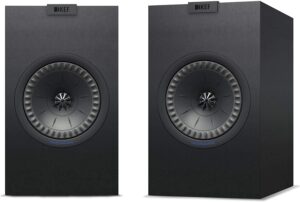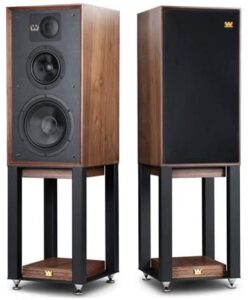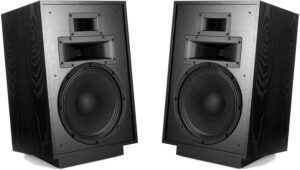Can’t find the best speakers for Marantz 2270? We prepared a list of several good options to help you make an informed decision.

The Marantz 2270 is an audiophile-grade vintage AVR guaranteed to drive most speakers, provided the receiver is in good condition. If you’re looking for high-quality speakers that your Marantz 2270 will make the most of, then go for speakers that’ll play your kind of music.
In other words, soundstage, bass reproduction capabilities, dissonance resolution, and other related sonic delivery aspects take precedence over matching specs.
The size of your room and the room acoustics will also influence your choice to a considerable extent. As a result, you’re spoilt for choice when it comes to shopping for quality speakers to pair with Marantz 2270. Take your pick from Wharfedale Lintons, Wharfedale Dentons, Klipsch, KEF, and Polk, or used Acoustic Research AR1, Dynaco A25, and much more.
The 3 Best Speakers for Marantz 2270
| Image | Model | Price |
|---|---|---|
 | KEF Q150B (Top Pick) | Check Price |
 | Wharfedale - Linton (Close Runner-Up) | Check Price |
 | Klipsch Heresy IV | Check Price |
KEF Q150B (Editor’s Choice)
The KEF Q150B punches above their weight, filling every sq. inch of your living room with dynamic sound, despite being compact bookshelf speakers. Featuring a two-way bass-reflex design, the Q150B speaker is equipped with the 5.25” Uni-Q driver array and a CFD-reinforced port for optimal performance.
The Q150B’s Uni-Q driver range, together with a CFD (computational fluid design) port layout, aids in the reproduction of realistic and detailed sound with lucid and taut bass.
The exclusive Uni-Q driver array forms the crux of the highly advanced state-of-the-art Q Series from KEF. The patented Uni-Q driver array positions the tweeter in the midrange cone’s acoustic core, facilitating pinpointed focused reflection of the cleanest audio. To put things in perspective, Q150B outputs 3D sound superior in clarity and detail and more uniformly diffused spatially than a standard speaker.
The ultra-wide 3D stereo imaging scattering capability of Uni-Q receives an extra boost from the proprietary ‘tangerine’ waveguide across the tweeter. In addition, incorporating the damped tweeter loading tube helps in mild extermination of audio emerging out of the tweeter’s rear. At the same time, the damped tweeter loading tube helps boost up lower treble reproduction significantly.
An all-new low-distortion inductor on the crossover goes a long way in putting out cleaner and brighter bass. This pair of Q150B bookshelf speakers excel in thoroughly bringing out the subtleties of bass instruments easily and almost instantaneously. In addition, the KEF drivers now come equipped with a brand new suspension and a broader role surround for reflecting beefier bass.
On the other hand, a refurbished cone layout and the improved ABR (Auxiliary Bass Radiator) aids in enhancing midrange clarity and bass reproduction. In addition, KEF sound engineers have embedded the Uni-Q in a sealed cabinet to ensure the cone delivers pure and detailed bass without putting undue stress on it.
Advanced and innovative driver design guarantees the DC obstructing capacitor’s exclusion from the crossover leading to a more realistic rolling motion among drivers.
A CFD (Computational Fluid Design) port structure where the port is relocated or transposed to the speaker’s back helps in clearer sonic reproduction. The CFD port’s rear-end positioning also aids in minimizing leakage of midrange audibility via the port.
The central positioning of the Uni-Q in the enclosure helps reduce reverberation inside the cab and the likelihood of stagnant waves. In addition, the port’s geometry has been adequately fine-tuned and tweaked for diminishing turmoil at elevated levels, thus reducing port noise and lesser low frequency (LF) compression.
Pros
- It can be effectively driven by Marantz 2270
- It delivers incredibly clean, bright, and beefy sound and doesn’t sound raucous even when driven hard
- Upgraded and advanced 5.25” Uni-Q driver array
- All-new cabinetry with a sleek finish
- Uni-Q driver array positioned centrally for a focused single point source sound reproduction across the frequency bandwidth
- Lightweight but durable aluminum woofer cone together with Z-flex surround for better cone control and low distortion
- Damped tweeter loading system for a smoother sound with more detailed bass and reduced distortion
Cons
- You’d struggle to remove the banana plug caps
- Bass reproduction is not as effective as it should have been
Wharfedale –Linton (Close Runner-Up)
To be precise, the lineage of Wharfedale Linton loudspeakers can be traced back to more than 50 years back 1965, to be precise. Linton speakers and amplifiers enjoyed universal popularity throughout the ’60s, ’70s, and ’80s and continue to be highly sought-after for their performance and aesthetics. Even 56 years after their advent, the Wharfedale speakers from Linton have by and large retained their vintage design and features.
The state-of-the-art Wharfedale loudspeakers keep on delivering precisely the same way their predecessors did, holding audiophiles in thrall. However, while retaining the original layout, the brand new Wharfedale-Linton speaker (with a walnut stand) has better sound quality. In addition, the introductory Linton speakers featured woven Kevlar fabric regarded as a highly exotic material used exclusively by NASA.
Nevertheless, in the current line of Lintons, Kevlar finds extensive application where the fabric is taken good advantage of in the midrange and bass drive units. And together with the smooth dome tweeter, the Kevlar bass and midrange driver units offer the speaker an extroverted, open soundstage typified by detail high-end and punchy low-end. Audiophiles and music buffs quickly warm up to these Wharfedale speakers thanks to their high efficiency.
This super-efficient Linton loudspeaker has a 90dB sensitivity rating implying that even low-powered amplifiers (20W of power or slightly above) can quickly drive the speaker. The Wharfedale stand-mount speaker, broader and taller than most bookshelf speaker models out there, has a commanding presence. The speaker comes with its stand (made from walnut wood), enabling you to mount the unit with remarkable ease.
The natural wood finishing and the dark framework perfectly counterbalances the ‘big box’ design or form factor enabling the speaker to gel with the room’s décor. The hefty box style also goes a long way in letting the speaker deliver profound bass and quite effortlessly. The matching walnut stand provides firm support to the unit and comes with a shelf for keeping vinyl records and DVDs safely.
The latest Wharfedale loudspeaker is an impeccable embodiment of the reasonable balance between high-level craftsmanship and organic sound quality that Linton has perfectly fine-tuned over the years. This three-way speaker has been made upholding the long-standing Wharfedale tradition; it features a classic cloth grille, inset front baffle, and veneered painstakingly by hand.
The Wharfedale Linton makes the most of modern-day technology and integrates the best of vintage design attributes. The knitted textile soft-dome treble unit comes with a high-flux ferrite magnet that helps belt out flat and detailed HF extension. In addition, the interlaced Kevlar cone positioned atop a solid die-cast chassis and a smaller Kevlar coned unit facilitates delivery of focused warm bass and midrange frequencies.
Pros
- Pair of bookshelf speaker with mounting walnut stand
- A three-way loudspeaker (design) housed in hand veneered enclosure
- Vintage Wharfedale styling natural-sounding audio
- Judiciously combines the original’s warm and loaded audio with the detailed open contemporary soundstage
- Excellent sonic imaging and timing thanks to discretely housed Kevlar woofer, Kevlar midrange tweeter, and soft dome tweeter
- Heavy-weight gorgeous stand for providing stable support to the speaker
Cons
- It needs a lot of headroom for installation
- Vocals and voices may not find full articulation
Klipsch Heresy IV
The Heresy launched in the year 1957 featuring a three-way layout was designed to work as a compact center-channel speaker in conjunction with the Klipschorn® in a three-speaker stereo rig.
Fast-forwarding to 2006, you have the Heresy III with a titanium diaphragm for slick and precise definition, tweeter and midrange compression drivers, and an extra-powerful bi-wired network. And the Heresy IV is even more versatile thanks to its brand new K-702 midrange compression driver.
The Klipsch Heresy IV also scores a first of sort as this speaker comes equipped with a rear-firing port. As a result, the Heresy IV brings out the best of everything you throw at the it-vinyl turntable, MP3 player, home theater, or anything. Like all other Klipsch speaker models, this Heresy IV center-channel/tower speaker is a fitting testimony to the excellence in craftsmanship that the Indianapolis-based company has attained in 75 years.
Heresy IV comes with a K-702 midrange compression driver sporting a polyamide diaphragm that brings out every note with exceptional clarity. In addition, the K-702 midrange speaker driver offers a well-balanced response filling up every sq. inch of your room with booming music owing to its pairing with the the-704 Tractrix® Horn.
The Heresy, which has wowed audiophiles throughout its over six decades of existence, now includes a rear port for the first time.
The rear-firing port helps boost up low-frequency reproduction by nearly 10Hz for surround sound bass. The introductory Heresy IV port makes the most of Tractrix geometry for enabling audio signals to travel via the shortest possible route. This helps bring down air turbulence infiltrating the port resulting in reduced port noise leading to more powerful and cleaner bass.
The high-quality aluminum input panel can house hefty top-notch speaker cables while rock-solid premium binding posts furnish bi-amping or bi-wiring capability. In addition, the robust long-grain copper conductors, nitrogen-infused PE, and Star-Quad geometry internal wiring guaranteeing clean signal transfer attest to the quality, efficiency, and versatility of Heresy IV.
Pros
- It comes reinforced with an all-new rear-port for lightning-fast air transfer for port noise reduction to reproduce more powerful bass
- Klipsch Tractrix ports featuring custom-built inner flares for minimizing air turbulence
Cons
- It takes a lot of time for breaking in
- Calls for meticulous mounted placement (a reasonable distance from the wall) for opening up the soundstage
Will New Speakers Work With An Old Receiver?
Speaking, you can pair any vintage AVR or amplifier with a wide range of modern-day speakers or vice versa. However, to be on the safe side, you’ll need to doubly ensure the ohmic or resistance loads of your speaker’s matchup with that of the receiver/amp. For instance, if your speakers have an impedance rating of 4ῼ, always make sure that the amp has an identical resistance rating.
Once you are sure that the resistance of both your new speakers and old receiver (or new amp and old speakers) correspond, you can start developing your home theater or stereo rig. That said, it can be quite challenging to evaluate ‘new’ versus ‘old’ resistance (matching power ratings also matter hugely) comprehensively as different manufacturers rate their specific products in distinct ways.
Contemporary receivers and amps are capable of streaming or can be made to stream (via Bluetooth, TuneCore, or Play MPE), pass through HD 3D, and so on, and cheaply at that. All in all, match the timbre of your new speakers and old receiver for a textbook soundstage over the front.
Different standalone integrated amps come with highly accurate ratings even to this day, enabling you to compare and contrast power ratings precisely. For instance, if you contrast a 6.2 surround sound AVR with a 7-channel amp, the receiver literature might specify 60W per channel or 60W + 60W (2-channel). So if you power all the six channels (of the receiver), the output (power) is considerably reduced.
The external discrete amp’s power rating specs may signify that the unit can put out 75W per channel with all channels firing, rendering the amp a genuine 75W unit under any condition. For instance, assume that the power requirement of your speakers, by and large, is 6 watts. However, if you enjoy listening to high-decibel music, then you will push your amp beyond its limits more often.
So if you pair the speakers with a 20W-rated receiver, it’ll peter out at 20W, leading to distortion ultimately damaging your speakers. But if you have an 80W amp, then you’ll be able to immerse yourself in premium audio with complete peace of mind. Nevertheless, you should also be wary of using an ultra-high power amp with your speakers, as you always risk burning the speakers.
Why Are Vintage Marantz Receivers So Expensive?
Marantz amps and receivers with Denon (two different brands owned and promoted by the same manufacturer) command a slightly higher price than most brands. As a result, it is not unusual to come across vintage Marantz AVRs with 50W output per channel costing much more than contemporary receivers pumping out 70-100W per channel. For instance, the Marantz Model 2 Amplifier (introduced in the ‘60s) could set you back by nearly $15000 (USD).
On the other hand, you’ll find several high-end, versatile modern-day amps and receivers under $3,500-$4000 or even lesser. Now, why’s there such a wide variance in the prices of vintage and modern audio equipment? For a start, the sought-after vintage amps, receivers, mics, mic preamps, equalizers, and compressors tend to be collector’s items owing to their rarity.
The second reason is that older equipment is made using top-quality components and durably designed to make them last longer. No wonder vintage-grade audio gear is capable of performing beyond your expectations. Marantz has been in existence since 1953, and over the decades, has entrenched its goodwill in the market by consistently producing top-notch products.
So, The Best Speaker for Marantz 2270 Is…
Consider yourself extremely fortunate if you own a vintage-grade Marantz 2270 receiver that’s still in running condition. All the speaker brands listed and reviewed above are guaranteed to bond seamlessly with your Marantz 2270.
So if you’re seriously thinking about buying yourself a set of new speakers for mating with the Marantz receiver, check out the speakers’ performance at a showroom. Our favorite is the KEF Q150B: in our opinion, it’s the best speaker for Marantz 2270 available on the market at the moment.